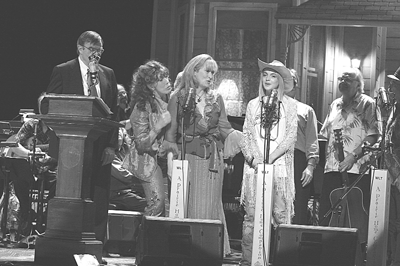By Leonard Quart
For me the highlight of the pedestrian 2005 Oscar ceremony was the granting of an honorary Oscar to the director, Robert Altman – a still-working octogenarian who has had a luminous and prolific career. Still, despite his having received five Academy Award nominations for best director, he like Hitchcock, Lumet, and Scorsese (a testimony to Hollywood’s aesthetic obtuseness), has never won an Oscar.
Altman is a visionary, iconoclast and Hollywood outsider who has made such fine films as “M*A*S*H,” “The Player,” “Short Cuts,” “Thieves Like Us,” and “Gosford Park,” and great ones like “Nashville,” “McCabe” and “Mrs. Miller and The Long Goodbye.”
In his best films Altman emphasizes behavior rather than plot and exposition, uses a great deal of improvisation, and packs his films with dazzling and intricate aural effects and visual images. He is the master of overlapping dialogue, and a film frame filled with brimming, elusive detail.
His 39th and latest, “Prairie Home Companion,” is a satiric comedy, that is less ambitious and much slighter than Altman’s best work but still inventive and charming. It’s a fictional version of Garrison Keillor’s beloved, and for some people irritating, long-running public radio program of the same name. It stars a laid-back, cannily folksy Keillor (who wrote the script) and some of the show’s regulars, who are effortlessly integrated with marquee actors like Meryl Streep, Kevin Kline, Liily Tomlin, Woody Harrelson, Tommy Lee Jones, and ubiquitous teen-age idol, Lindsay Lohan.
The film’s narrative imagines that the radio show is giving its last broadcast before being closed down by some giant, impersonal corporation, but whatever minimal plot the film contains is never really followed up on. “Prairie Home Companion” is basically a shaggy dog story using long unbroken takes of backstage banter with the camera fluidly moving to catch off-the-cuff exchanges between the sister act, the Johnsons (a vibrant, glamorous Streep who the camera loves, and a sharp-tongued Tomlin), and the one-upmanship between the singing cowboys, Dusty and Lefty (Harrelson and John C. Reilly). Altman orchestrates the backstage din seamlessly, but there are times the repartee goes slack.
About half the film takes place onstage, and since Altman has a gift for using music innovatively (e.g. “Nashville”), the film comes most alive at these moments. The cast sings gospel, folk, and cowboy music, and comic commercial jingles with panache.
An added frisson is Virginia Madsen, a blonde femme fatale dressed in a white trench coat. Though she loves the show, Madsen acts as the angel of death who walks around observing the film’s other characters. She embodies, in an unthreatening way, the sense of mortality that confronts Altman, his characters, and the program itself.
Implicit in “Prairie Home Companion” are motifs that run through Altman’s work: a commitment to an informal community; a belief in the profane, the spontaneous, and the personal; and contempt for the coldness and calculation of powerful institutions like corporations. It’s also an unsentimental homage to radio and Keillor’s program itself. The film may be slender, but it’s still more original and imaginative than most of the slick Hollywood products that are being shown in the multiplexes.





























